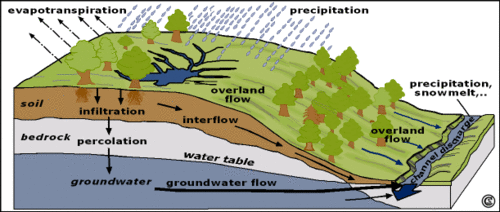Hydrological Cycle
The hydrological cycle
Image Credit: after data from Ahnert 1996, 175-177; Bradshaw and Weaver 1995, 45
The hydrological cycle describes the movement of water within the Gina River catchment (see figure). As this movement refers to the circulation of water between the individual reservoirs of the watershed it is termed local water cycle. If the global hydrological system is viewed it is termed global water cycle. During the circulation water changes its aggregate state (both hyperlinks will navigate you to explanations in German, illustrated by figures).
The cycle starts when
- water falls as precipitation (rain, snow, etc.);
- to some extent it is intercepted by the vegetation;
- precipitation which reaches the land surface evaporates partially;
- together with the amount of water which is transpired by the plants, part of the fallen precipitation returns to the atmosphere (this process is termed evapotranspiration);
- the other part of the precipitation may partially infiltrate into the soil (subsurface water);
- if the subsoil layer is saturated by water or if pipes exists, the infiltrated water runs as interflow downward inside the soil;
- some amount of water percolates deeper into the bedrock and enters the groundwater reservoir. The top of this zone is termed the water table. Water which is stored as groundwater in pores and fissures runs with long delay as base flow to the receiving water;
- the precipitation that reaches the soil surface and was not absorbed by the soil may be stored temporary in puddles on the surface if the upper soil is impermeable or saturated with water. It becomes unchannelled overland flow which runs directly from the slope to the Gina river (receiving water body) if rainfall continues (Ahnert 1996, Mendel 2000).
These hydrological processes can vary which is explained on the following page.
